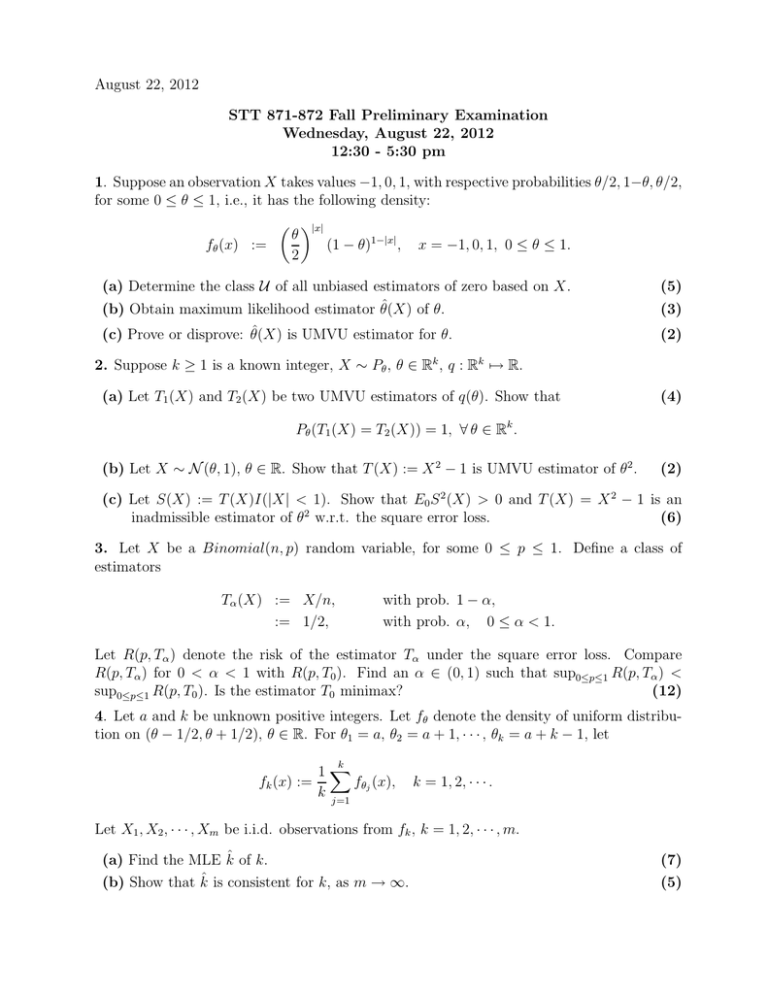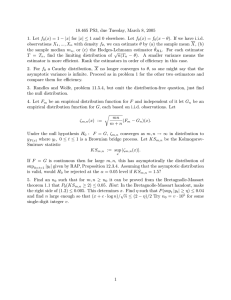August 22, 2012 STT 871-872 Fall Preliminary Examination Wednesday, August 22, 2012
advertisement

August 22, 2012 STT 871-872 Fall Preliminary Examination Wednesday, August 22, 2012 12:30 - 5:30 pm 1. Suppose an observation X takes values −1, 0, 1, with respective probabilities θ/2, 1−θ, θ/2, for some 0 ≤ θ ≤ 1, i.e., it has the following density: |x| θ (1 − θ)1−|x| , fθ (x) := 2 x = −1, 0, 1, 0 ≤ θ ≤ 1. (a) Determine the class U of all unbiased estimators of zero based on X. (b) Obtain maximum likelihood estimator θ̂(X) of θ. (5) (3) (c) Prove or disprove: θ̂(X) is UMVU estimator for θ. (2) 2. Suppose k ≥ 1 is a known integer, X ∼ Pθ , θ ∈ Rk , q : Rk 7→ R. (a) Let T1 (X) and T2 (X) be two UMVU estimators of q(θ). Show that (4) Pθ (T1 (X) = T2 (X)) = 1, ∀ θ ∈ Rk . (b) Let X ∼ N (θ, 1), θ ∈ R. Show that T (X) := X 2 − 1 is UMVU estimator of θ2 . (2) (c) Let S(X) := T (X)I(|X| < 1). Show that E0 S 2 (X) > 0 and T (X) = X 2 − 1 is an inadmissible estimator of θ2 w.r.t. the square error loss. (6) 3. Let X be a Binomial(n, p) random variable, for some 0 ≤ p ≤ 1. Define a class of estimators with prob. 1 − α, with prob. α, 0 ≤ α < 1. Tα (X) := X/n, := 1/2, Let R(p, Tα ) denote the risk of the estimator Tα under the square error loss. Compare R(p, Tα ) for 0 < α < 1 with R(p, T0 ). Find an α ∈ (0, 1) such that sup0≤p≤1 R(p, Tα ) < sup0≤p≤1 R(p, T0 ). Is the estimator T0 minimax? (12) 4. Let a and k be unknown positive integers. Let fθ denote the density of uniform distribution on (θ − 1/2, θ + 1/2), θ ∈ R. For θ1 = a, θ2 = a + 1, · · · , θk = a + k − 1, let k fk (x) := 1X fθ (x), k j=1 j k = 1, 2, · · · . Let X1 , X2 , · · · , Xm be i.i.d. observations from fk , k = 1, 2, · · · , m. (a) Find the MLE k̂ of k. (b) Show that k̂ is consistent for k, as m → ∞. (7) (5) 5. Let X1 , X2 , · · · , Xn be i.i.d. r.v.’s from the parametric density 2 fθ (x) := 2θxe−θx , x > 0, θ > 0. (a) Derive UMP unbiased test of size 0 < α < 1, for testing H0 : θ = 1, vs. H1 : θ 6= 1, in the fullest possible detail. (8) (b) Discuss the corresponding confidence interval for θ. What optimality properties does it have, if any. (4) 6. Let Y1 , · · · , Ym and Z1 , · · · , Zm be mutually independent observable r.v.’s with Yi ∼ N(ξi , σ 2 ), Zi ∼ N(ξi + c, σ 2 ), i = 1, 2, · · · , m. Here, ξ1 , ξ2 · · · , ξm , c and σ 2 are all unknown parameters. Consider the problem of testing H : ξ1 = ξ2 = · · · = ξm vs. K : not H. (a) Obtain the explicit expression for the residual sum of squares, SSE, under the full model H ∪ K and show that it is non-negative, and describe the F -test for the above problem in complete detail. (8) 2 (b) Is the estimator SSE/(m − 1) consistent for σ , as m → ∞? (4) Pm −1 2 ¯ (c) Consider the alternatives where m i=1 (ξi − ξ) → ψ > 0, as m → ∞. Show that the power of the test in (a) for these alternatives converges to 1, as m → ∞ (4) 7. Recall that in the regression model Yi = ci β + τi ηi , where the r.v.’s ηi ’s have zero mean and unit variance, and ci , τi > 0 are known the weighted least square estimator of Pn numbers, −2 β is obtained by minimizing the sum i=1 τi (Yi − ci b)2 w.r.t. b. Let 0 < x1 < x2 < · · · < xn be known positive numbers. Suppose that the observations Yi ’s are generated by the following model: Yi = xi β + Ui , Ui = e1 + e2 + ... + ei , i = 1, 2, ..., n, where ei , 1 ≤ i ≤ n are i.i.d. r.v.’s with mean 0 and Var(ei ) = σ 2 (xi − xi−1 ), i = 1, · · · , n, where x0 = 0. (a) Obtain the weighted least square estimator β̂ of β and show that it depends only on xn and Yn . Prove the consistency of β̂ for β. Explicitly state the assumptions needed for consistency, if any. (10) (b) Derive an expression for the test statistic for testing H0 : β = 1 vs H1 : β > 1 and describe the distribution of the test statistics under H0 . (5) 8. (a). Let X, Xi , i ≥ 1 be i.i.d. r.v.’s with EX = 0, σ 2 := EX 2 , τ := EX 4 < ∞. Let −1 Tn := n n X i=1 Xi2 1/2 . Derive the asymptotic distribution of n1/2 (Tn − σ). (7) 1/2 (b). Suppose a sequence of r.v.’s Yn is such that for some constants a and b > 0, n (Yn − a) converges in distribution to N (0, b2 ). Then are the following statements true or false, in general. (4) (i) limn→∞ EYn = a. (ii) limn→∞ Var(Yn ) = b. 2









